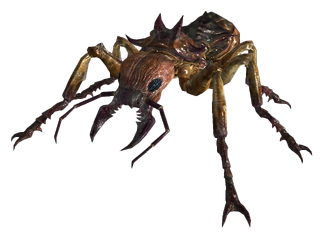| For an overview of giant ant variants in the Fallout series of games, see giant ant. For an overview of fire ant variants in the Fallout series of games, see fire ant. |
Giant ant | |||||||||||||||
| |||||||||||||||
| |||||||||||||||
Giant ants are mutated insects found in the Mojave Wasteland in 2281.
Background[]
These mutated arthropods, of order Hymenoptera, family Formicidae, and genus Camponotus (commonly called carpenter ants) were exposed to large levels of radiation. However, what really caused this rapid evolution and adaptation to the wasteland, creating what is known as a giant ant[1] ("big fucking ant" to some)[2] was exposure to Force Evolutionary Virus lingering in the fallout.[3] Their increased mass and strength makes them highly dangerous to large prey and even humans, as their mandibles are capable of cutting through leather, plastic, and even bone. Their exoskeleton can shrug off punches and most kinds of blunt trauma, but remains vulnerable to firearms and sharp weapons. Great ants are also quite sensitive to antennae trauma. Damage to their primary sense organ reliably sends them into a frenzy, attacking anyone and anything in the vicinity.[4] Like their forebears, ants have a strong swarm instinct and will attack prey in packs or double-down to protect the nest if their queen is threatened in any way.[5]
Characteristics[]
Biology[]
Giant ants are large insects protected by a yellow-brown carapace. They have large mandibles which they use to both hunt and protect themselves. The long antennae they have sprouting out of their head act like sensors, allowing them to take in more information about their immediate environment.
Gameplay attributes[]
These creatures can be a bit of a problem in early stages of the game. Hitting their antennae will count towards a critical hit and will also frenzy them. Like their east-coast brethren, they are not particularly swift, and can easily be out-walked if the player prefers to engage them at range. Since they have no Damage Threshold, it is a good choice to use low-damage, high-DPS weapons.
Variants[]
Giant soldier ant[]
The largest and strongest variant of the more common giant ant variants. This ant can be found accompanying smaller ants as they forage. Several can be found inside the Allied Technologies offices building.
| Name (Base ID) | Statistics | Behavior | Abilities | Items | ||||
|---|---|---|---|---|---|---|---|---|
| Giant soldier ant 0001cf80 00102aad |
|
|
| |||||
| Giant soldier ant 00102aad |
|
|
| |||||
| Giant soldier ant 0015c7be 00169dd5 00169dd8 |
|
|
|
Giant worker ant[]
What they lack in individual fortitude, they make up for with relentless attacks and swarm tactics. However, a worker ant's exoskeleton isn't particularly hard compared to radscorpions. Their mandibles can cut through most leather and plastic with ease, even snapping bone on a lucky shot.
Giant worker ants can usually be found in barren stretches of desert in the Mojave such as the Ivanpah race track or Ivanpah Dry Lake. They usually walk around in groups, presumably looking for food.
| Name (Base ID) | Statistics | Behavior | Abilities | Items | ||||
|---|---|---|---|---|---|---|---|---|
| Giant worker ant 00102aae |
|
|
| |||||
| Giant worker ant 0001cf81 0015c7bf |
|
|
|
Giant ant queen[]
The giant ant queen (or fire ant queen) is the largest creature in the Mojave Wasteland. Only one ant queen appears in Fallout: New Vegas, located in the Ant Mound south of the Allied Technologies Offices and Camp McCarran, or north-west of REPCONN headquarters.
| Name (Base ID) | Statistics | Behavior | Abilities | Items | ||||
|---|---|---|---|---|---|---|---|---|
| Giant ant queen 0015e908 |
|
|
|
Related quests[]
Appearances[]
Giant ants appear in Fallout: New Vegas.
Notes[]
- The ants at the Nellis array will explode when shot with energy weapons due to their consumption of munitions.
- One can observe ants walking in lines, much like worker ants in reality
- When near Virgin Fork Campground Follows-Chalk says giant ants are called picnic-killers. He doesn't know why, and says it's probably from "back when".
Bugs[]
- Sometimes when using Explosives or Unarmed methods to attack the player won't damage the ant.
Gallery[]
See also[]
References
- ↑ Vault 101 terminals; Overseer's Terminal, Report 2241-02-10: "We encountered a group of monstrous ants which appeared to confirm Mackay's theories of mutation due to extended exposure to radiation. We drove off the ants with gunfire and collected several specimens for study upon return to the vault (see Exhibit A)."
- ↑ Chosen One in Broken Hills
- ↑ Fallout Bible 1
Fallout Bible 0: "3. Are the radscorpions a product of the FEV virus? When you talk to the doctor, Razlo, in Shady Sands, he tells you that they were once American Emperor Scorpions but that he has no idea how they mutated because radiation alone couldn't have done it. For that matter, what about all of the other creatures of the wasteland? Which ones have been mutated by FEV and which ones haven't? Maybe in the bestiary each creature could have a stat that shows it's level of FEV infection."
"Answer:- The radscorpions are a result of a combination of radiation and the FEV virus, and Razlo in Shady Sands is correct - they were originally Emperor Scorpions that have grown... big.
- FEV-Infected Critters in the wasteland include almost all the ones you've seen in F1 and F2:
Mantises.
Most species of rats.
Gecko lizards.
Brahmin
Scorpions
Ants
Various varieties of plants, including the Venus Flytrap.
Rumor has it some dogs were affected, but no one's seen any, so for now that's just rumor. Of course, the centaurs are a mash of human, dog, and various other parts... but hey, who knows how that mutation came about. Grey was probably messing around in one of his labs. - Creatures not mutated by FEV probably did not survive the aftermath of the Great War, with the possible exception of cockroaches... and perhaps normal ants, though there are FEV-infected versions of these species.
- No one knows where those bird noises in Vault City came from.
- I'll try to include a chart of FEV-infected creatures in future additions as well as other critters that you may not have seen in F1 and F2. Most likely a great majority of insects were affected (they tend to breed much faster, and their mutations tend to become evident pretty quickly as the generations advance), possibly beetles, some spiders, cockroaches, and other creatures."
- ↑ Enclave field terminals; Enclave Field Research Terminal (silo outpost), Field Entry: Giant Ant: "Kingdom: Animalia
Phylum: Arthropoda
Class: Insecta
Order: Hymenoptera
Family: Formicidae
Genus: Camponotus
I've determined with near certainty that the aboriginal Ants are of the genus Camponotus. My best guess would be that a majority of the ants encountered are black carpenter ants (Camponotus pennsylvanicus). However, given that this particular genus consists of over a thousand different species, classification has been difficult. Prior generations of the genus were only considered a nominal threat to humans, but their social and fiercely territorial nature, combined with the greatly increased mass of current varieties has made them extraordinarily dangerous. The antennae of the ant is the primary sense organ, and soldiers report disabling this to be a successful tactic, as it sends the ant into a frenzy whereupon it attacks anything nearby, human or ant." - ↑ Simple critters, Giant Ant: "Giant ants are nothing to be laughed up. What they lack in individual fortitude, they make up for with relentless attacks and swarm tactics. Their exoskeleton isn't particularly thick, but it can turn aside weak punches and dull knives. Their mandibles can cut through most leather and plastic with ease, even snapping bone on a lucky shot. Giant ants become particularly aggressive when their queen is threatened."





